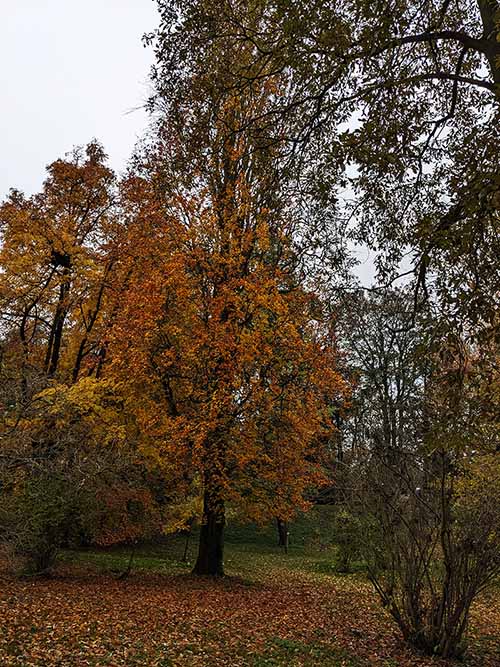#127 DAWYCK BEECH
Fagus sylvatica ‘Dawyck’

This tree is to the east of the Syringia Avenue.
Rated County Champion by The Tree Register in 2023.
| Distribution: | In the wild only found on the Dawyck Estate, Peebles, Scotland. Often used in urban plantings, due to its shape. |
| Planting Date: | January 1934, supplied by Hillier Nurseries, Romsey, Hampshire (as Fagus sylvatica fastigiata) |
| Appearance: | Large fastigiate deciduous tree (lifespan 150 years to 200-300 years) |
| Growth Habit: | Vertical branches form a broadly columnar, spear-shaped, profile. |
| Bark: | Smooth, thin, silver-grey bark with occasional slight horizontal markings. Shallow root system spreading in all directions. |
| Leaf: | Distinctive buds: pointed cigar-shaped to 2 cm, unfurl to silky ovate to obovate leaves with wavy edges but no teeth. Autumn display of golden yellow and ginger-orange. |
| Flowers: | Inconspicuous flowers, males yellow, females green, are borne in clusters on the same plant, as the leaves unfold in mid-spring. |
| Fruit: | Two nuts contained in two three-sided, stiff-skinned cases fitting snugly into a bristly brown outer case that later opens widely into four ‘petals’ to release edible seed. |
| Toxicity: | Slightly toxic in large amounts due to tannins and alkaloids, but nuts can be ground into flour after undergoing a leaching process. |
| Tree size in 2023: | Height 27 m and girth 230 cm (at 1.5 m height) |
| Uses: | Beech has fine, short, grain which is good for carpentry and furniture making. Used for wooden mallets and workbench tops it resists compression and splitting. It is liable to rot if used untreated outside. High cellulose content makes Beech better than many other wood for paper pulp and it can be spun into Modal fabric a cotton-like textile. It is a good wood for burning. |
| Plant Hunter: | A chance discovery by Sir John Naesmyth on his Dawyck estate in Peebleshire. In 1860, he came across an unusual looking seedling near Dawyck Mill, and had the plant transplanted to the grounds of the house, so he could keep an eye on its development. It developed into a tall, thin column, quite different to the typical growth form of the common Beech. |
| Introduction Date: | 1907 |
| Comments report | A report by Tony Titchen in 2004 lists this as a very good specimen. He observed it to be product of seed, and not grafting, on account of the occasional ‘wide’ growing branch more typical of the Common Beech. Grafted specimens tend to be 100% fastigiate. Presented as a 75th birthday gift to Mr Hammond from his brother Ralton. Rated County Champion in April 2023 by height and girth by The Tree Register. |